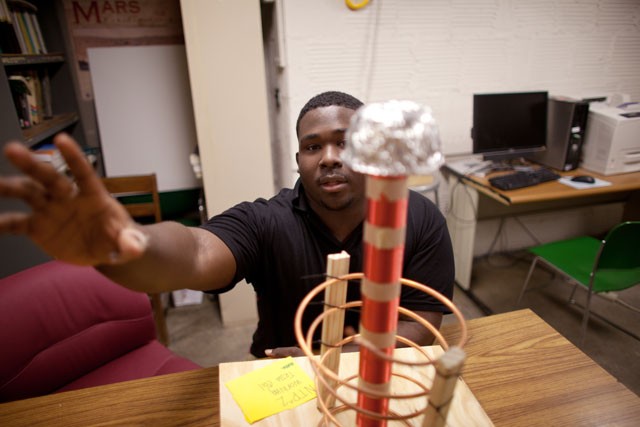One student group plans to go higher than ever before, reaching heights that even airplanes donâÄôt come close to, with its latest project.
The Nikola Tesla Patent Producers student group, known as NTP², plans to launch a near-space balloon early this fall.
The balloon, which the group began working on in early spring semester, will reach about 22 miles into the sky and travel for up to five hours, group member Charles Brown said.
Since the group started last fall, it has worked on many projects like the balloon, and the endeavors vary with a single goal: to patent something useful.
âÄúWe have a lot of big ideas,âÄù Brown said.
Before launching, the balloons can be as large as a car, said James Flaten, an aerospace professor whoâÄôs taught classes on making weather balloons. By the time the balloon is about to burst at its highest altitude, it becomes as large as a house, he said.
These balloons reach about 100,000 feet on average, while airplanes stay at 30,000 feet, Flaten said, adding that the balloons typically travel 50 to 60 miles during their lifetime âÄî pre-burst.
After being launched from a site a couple hours north of the Twin Cities, NTP²âÄôs balloon will record temperatures, altitudes, magnetic fields of the earth and take photos, Brown said. The data recording equipment is stored in a plastic foam box, which is attached to the balloon. The group plans to follow its path by tracking the GPS attached to it.
The group is also working on a âÄúhandheld electrostatic generator,âÄù a special type of glass and a rotating disc that build a charge from rabbit fur to store electricity, produce a shock or possibly charge batteries, Brown said.
The approximately 30 members meet weekly during the school year, conducting âÄúthink tanksâÄù to come up with new ideas, he said. After members decide on different projects, each student focuses on a certain part. Brown was a consultant last year, helping each group when needed.
Along with the electrostatic generator, NTP² created an iPhone application called Study Spaces, which the group will finish a month into fall semester, Brown said.
The Study Spaces application will provide information about the noise level of an area, how many people are there and whether food and drinks are available.
âÄúOur goal is to patent something that people need,âÄù Brown said.
However, this goal might be a challenge for the group, since a patent costs $8,000 to $10,000 and itâÄôs a âÄúvery, very long processâÄù to get one, Brown said.
While NTP² receives funds from Student Unions and Activities and the Minnesota Student Association, the group hopes that, when the time comes to patent, grants and help from professors will make it possible, he said.
Even with unsuccessful experiments, group members learn from the process, Brown said. The students have hands-on opportunities to test theories discussed in class, allowing for a clearer understanding of an idea.
Next year, the group will be learning more about the creative thought processes that inventor and engineer Nikola Tesla once used, said Michael Cameron, president and founder of the group.
One method the group will learn more about is âÄúimage streaming,âÄù Cameron said. Tesla used this technique, in which one imagines every possible outcome, problem or possibility an idea could have.
âÄúWe try to think outside the box and see what we come up with,âÄù Cameron said.


